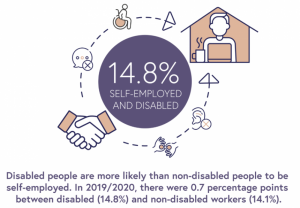It’s great news for Britain as a whole and for disabled Brits even more so as number in work has risen by 53% in the last eight years.
Ricky Towler, founder of Middletons mobility solutions, discusses their latest research into accessibility concerns facing disabled workers in the UK and how businesses can best to support disabled workers.
- One fifth of the working-age population in the UK are classed as disabled
- There were 4.4m disabled people in employment in the UK in 2021, an increase of 1.5m from 2013 (an increase of 53.5%)
- More Brits are reporting a long-term health condition or disability than eight years ago, and the increasing number is largely driven by an increase in mental health conditions
- The disability employment gap is wider for disabled men, those with multiple disabilities, and those suffering from mental illness
- Disabled people are more likely to be self-employed than non-disabled people
The increase is driven by mental health conditions
Latest population figures suggest that a fifth of working-age Brits are currently classed as disabled, and data from 2021 showed that the number of disabled people in employment was more than 50% higher than almost ten years earlier. Alongside this, there are more Brits reporting long-term health conditions or disabilities than ever before – a figure that is being driven by an increase in mental health conditions across the nation’s workplaces.
But despite the growing number of the population who live with mental health conditions, the disability employment rate is much lower for these individuals. To understand why, mobility solutions experts Middletons Mobility have looked into how the increased population of disabled Brits are being supported in their places of work, and what UK businesses can do to help their disabled employees in the workplace.
The Disabled Workforce
The number of disabled people in employment in the UK increased from 2.9million in 2013, to more than 4.4m in 2021 according to latest government findings. While the increasing number of disabled people joining the UK workforce can be attributed to factors like the overall working-age population and prevalence of disabilities, the employment rate gap between disabled and non-disabled Brits is glaring.
Despite the massive growth in employment for Brits with disabilities, only 53.5% of disabled people aged between 16 and 64 years are currently in employment, versus the 81.6% of non-disabled people of the same age group. Furthermore, a gap was seen in the employment rates between disabled and non-disabled British men (31.1%) than for women (24.8%).
The employment rate is lower still for people with severe or specific learning disabilities, those with Autism Spectrum Disorder, and those with mental illness.
How businesses can support disabled employees
While there is currently government support available for eligible disabled employees to provide support in the workplace, there are many ways individual businesses can help their disabled workforce. From simply revising policies to ensure they are inclusive of all staff, to providing education around certain disabilities that impact teams within the business, employers must be aware of and provide assistance for the barriers that disabled people face at work.
Ricky Towler says: “Flexible working is a buzz term that is not going anywhere, as Brits are searching for things like “work from home” on average 30,000 times per month in the UK. If working from home isn’t an option, then simply addressing working hours, personal breaks and shift patterns can also support employees with disabilities, as can adjusting responsibilities of the employee.”
“Making a workplace accessible for disabled employees is a huge show of support from a business, especially if additional equipment or devices can be available for these employees. Installing ramps for mobility scooters or wheelchairs, modifying furniture to allow for wider access, or providing a sensory-free environment for overstimulated workers are all ways businesses can support their staff who have additional needs.”
Industries, Roles and Self-Employment
The research revealed that disabled people are more likely to be working in health, retail and education sectors than any other, with these industries accounting for 42.6% of disabled workers, and only 35.4% of non-disabled workers. Disabled workers are least likely to work in agriculture or forestry and fishing sectors, accounting for less than 1% of the total workforce in these industries.
It also highlighted that the gap between the proportion of disabled and non-disabled workers who are self-employed has been closing for a number of years. In 2021 figures showed that 13.6% of disabled workers were self-employed, compared to 12.7% non-disabled self-employed workers, a decline in both cases from 2013.
Analysis further showed that disabled workers are less likely to be in senior or management roles than their non-disabled colleagues, but more likely to be in lower-skilled occupations (despite qualifications), or in part-time work – presumably to allow for flexibility.
Read more about how businesses can support the disabled workforce
You may also enjoy reading about how to brake the stigma of disability in the workplace











